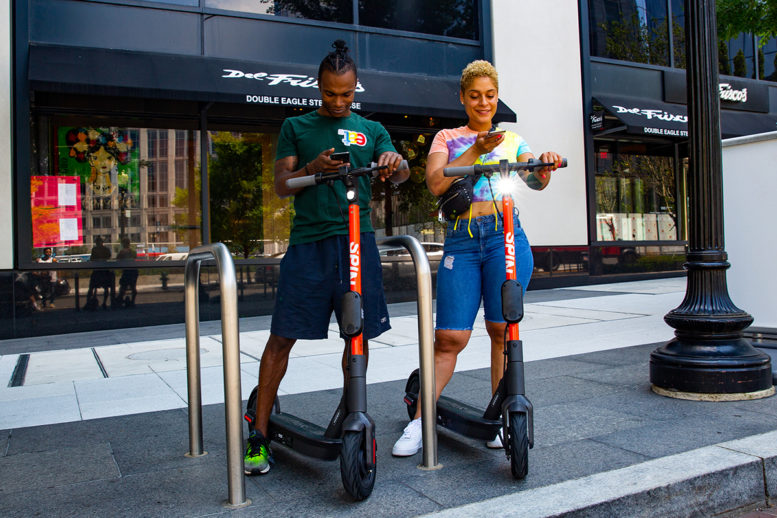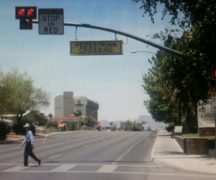By JAN LARSON McLAUGHLIN
BG Independent News
The brakes were pumped a bit Monday evening on legislation regulating electric scooter businesses in Bowling Green.
The scooter legislation was on City Council’s agenda for a final reading – but the issue was tabled after multiple changes were suggested.
At Monday’s hearing, council’s Community Improvement Committee also heard concerns from a citizen about scooters sharing streets with motor vehicles and sidewalks with pedestrians.
Sharon Stratmann asked where the scooters will be allowed to operate. Council member Jeff Dennis said the electric scooters will be considered vehicular traffic – like cars and bicycles.
“They will not be on the sidewalk,” he said. The exceptions will allow the scooters to be parked on sidewalks, and will allow them to be operated on sidewalks permitted at BGSU.
The scooters will have a maximum speed of 20 mph, and will not be allowed on roads with speed limits over 35 mph, Dennis said.
The local legislation allows the city to make the rules specific to Bowling Green. The state of Ohio has passed legislation allowing the use of electric scooters and authorizing local jurisdictions to pass additional regulations as they see fit – otherwise the state law governs.
During the public hearing on the legislation Monday evening, Dennis proposed some amendments, such as:
- Defining “micromobility devices” as bicycles, electric bicycles and electric scooters distributed by companies throughout the city to be rented per trip.
- Requiring the reporting of data and statistics such as: Users by gender and age; number of vehicles in circulation; daily, weekly and monthly active users; small vehicle usage including user miles and duration of rides; heat maps showing routes, trends, origins and destinations; customer comments and complaints; and reported collisions.
- Establishing fleet size requirements that set a minimum and maximum number of scooters and bicycles per business.
Dennis explained that the data reporting and fleet size requirements are based on legislation in place in Athens, Ohio.
The statistics will help the city gather information on transportation needs, he said.
“I personally hope that any company we are giving a license to is willing to capture this information,” Dennis said. “The burden on us could be very low.”
Dennis also voiced concerns about companies flooding the streets with rental scooters and bikes.
“I think we need to be very careful about the number we are permitting on the streets,” he said. “There are several operators who are interested in Bowling Green right now.”
But the two other members of the council committee reviewing the legislation expressed reservations about the data collection amendment.
Bill Herald questioned if the data collection might be too onerous, especially for small companies trying to break into the business.
“I don’t want it to be too burdensome,” Herald said.
Joel O’Dorisio expressed concerns about privacy issues, with so much information being asked about scooter and bike customers.
“I would prefer to request information we are going to use,” he said.
The council committee will meet again to discuss the proposed amendments prior to the Aug. 15 City Council meeting.
City staff has studied the Bowling Green State University policy on e-scooters, as well as legislation adopted in other Ohio cities. The goal is “to ensure that such mobility sharing systems are consistent with the safety and well-being of the citizens of Bowling Green.”
The legislation requires that the scooters come with a forward pointed lamp, a back reflector, and lists the following operating rules:
- Cannot be operated on sidewalks, except as permitted by BGSU.
- Cannot be operated on streets or highways with speed limits higher than 35 mph.
- Cannot exceed 20 mph.
- Riders must be at least 18 years old.
Based on experiences in other communities, Bowling Green’s legislation establishes parking regulations so that the scooters do not impede ADA accessibility.
Following are some provisions of the proposed e-scooter ordinance:
- Any business seeking to operate a shared electric scooter program within the city shall first enter into an agreement with the city.
- Providers shall provide easily visible contact information, including toll-free phone number and email address on each scooter for city employees and the public to report problems.
- The city reserves the right to terminate the “use agreement” for cause or woefully negligent practices.
- Providers will take reasonable steps to ensure that all riders understand the requirements of ADA accessibility and the importance of leaving ADA paths of travel clear and accessible.
- Providers may stage e-scooters in permitted parking areas. If a provider wants to stage in areas other than the public right-of-way, permission must be obtained from the city, property owner or public agency.
- Providers must adhere to all indemnification and insurance requirements.
The ordinance also outlines some restrictions for operating the e-scooters.
- No more than one rider will be allowed at a time.
- Riders must not carry items that require both hands.
- The scooters may be operated on shared bicycle/pedestrian ways, including on shared pathways in public parks and streets. Anyone riding an e-scooter on a bicycle/pedestrian pathway, and is approaching a pedestrian, should give an audible warning and yield to the pedestrian – dismounting if necessary.
- E-scooters are to stay on the right of street lanes, and offer the right of way to bicycles in bike lanes.
Parking requirements:
- Riders of e-scooters should park the devices upright on hard surfaces on the curb of the sidewalk, beside a bike rack, or in another area specifically designated for bicycle parking, or on the street next to an unmarked curb.
- Riders should not park scooters in such a manner as to block the pedestrian clear zone area of the sidewalk, or ADA paths of travel.
- Riders should not park the scooters where they interfere with the reasonable use of a commercial window display, or access to any building entrance.
- Riders may park e-scooters in on-street parking spaces in the following circumstances – when designated for scooters, where the curb is less than 3 feet wide, in neighborhoods with rolled curbs or inadequate sidewalk space, and in marked parking spaces designated for motorcycles.





